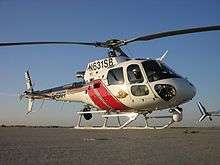Eurocopter AS350 Écureuil
The Eurocopter AS350 Écureuil (or Squirrel), now Airbus Helicopters H125, is a single-engine light utility helicopter originally designed and manufactured in France by Aérospatiale and Eurocopter (now Airbus Helicopters). In North America, the AS350 is marketed as the AStar. The AS355 Ecureuil 2 is a twin-engine variant, marketed in North America as the TwinStar. The Eurocopter EC130 is a derivative of the AS350 airframe and is considered by the manufacturer to be part of the Écureuil single-engine family.[3]
| AS350 Écureuil/AStar | |
|---|---|
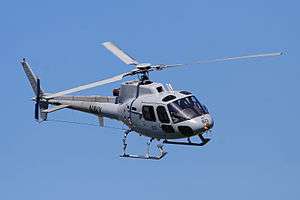 | |
| An AS350BA Squirrel of the Royal Australian Navy Fleet Air Arm at the 2008 Melbourne Grand Prix | |
| Role | Light utility helicopter |
| National origin | France |
| Manufacturer | Aérospatiale Eurocopter Airbus Helicopters Helibras |
| First flight | 27 June 1974 |
| Introduction | 1975 |
| Status | In service |
| Primary users | Brazilian Air Force Pakistan Army Aviation Royal Jordanian Air Force |
| Produced | 1975–present |
| Number built | 3,590 (AS350/AS550: 2009)[1] |
| Unit cost |
AS350B2: US$2.4M[2] |
| Variants | Eurocopter AS550 Fennec Eurocopter AS355 Écureuil 2 |
| Developed into | Changhe Z-11 Eurocopter EC130 |
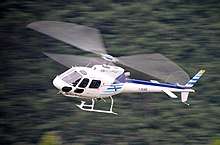
Development
In the early 1970s, Aérospatiale initiated a development programme to produce a replacement for the aging Aérospatiale Alouette II.[4] While the Aérospatiale Gazelle, which had been developed in the 1960s and 1970s, had been met with numerous orders by military customers, commercial sales of the type had been less than anticipated, thus the need for a civil-oriented development was identified.[4]
The development of the new rotorcraft, which was headed by Chief Engineer René Mouille, was focused on the production of an economic and cost-effective aerial vehicle, thus both Aérospatiale's Production and Procurement departments were heavily involved in the design process.[4] One such measure was the use of a rolled sheet structure, a manufacturing technique adapted from the automotive industry; another innovation was the newly developed Starflex main rotor. It was also decided that both civil and military variants of the emergent helicopter would be developed to conform with established military requirements.[4]
On 27 June 1974, the first prototype, an AS350C powered by a Lycoming LTS101 turboshaft engine, conducted its maiden flight at Marignane, France; the second prototype, powered by a Turbomeca Arriel 1A, following on 14 February 1975.[4][5] The Arriel-powered version, the AS350B, intended for sale throughout the world except for North America, was certified in France on 27 October 1977, while the Lycoming powered AS350C (or AStar) was certified by the US Federal Aviation Administration on 21 December 1977. In March 1978, deliveries to customers began for the AS350B, deliveries of the AS350C began in April 1978.[6]
Over time, the AS350 Écureuil/AStar has received further development; while the aircraft's design remains broadly similar, aspects such as the rotor system, powerplants, and avionics have been progressively improved. On 6 February 1987, a prototype AS350 B2 flew with a fenestron tail-rotor in the place of its conventional counterpart. On 1 March 1997, the first AS350 B3, equipped with an Arriel 2B engine, performed its first flight.[4] Conversion programs and addons for AS350s have been produced and are offered by third-party 'aftermarket' aerospace firms in addition to those available directly from the type's prime manufacturer. Variants of the Arriel-powered AS350B, AS350 BA, AS350 B1, AS350 B2, and AS350 B3, were progressively introduced; the later B3 differing from preceding models by the increasing use of digital systems, such as the Garmin-built G500H avionics suite and FADEC engine control system.[7]
Prior to 2013, the type had been manufactured principally at Eurocopter's Marignane facility, near Marseille, France; Eurocopter opted to, as part of a move to disperse its helicopter production activities, begin AS350 production and final assembly activities at its factory in Columbus, Mississippi for deliveries to U.S. commercial helicopter market. The Astar has been Eurocopter's biggest-selling product in the US commercial market, at one point selling roughly one AS350 every business day.[8][9] In March 2015, the first Columbus-assembled AS350 B3e received its FAA certification.[10] In December 2015, Airbus Helicopters reported their intention to double the rate of AS350 production at Columbus in 2016 over the previous year, and that the facility is capable of producing up to 65 AS350s per year.[11]
Design
The AS350 is a single engine helicopter, powered either by a Lycoming LTS101 or Turbomeca Arriel powerplant (for twin-engined variants, see Eurocopter AS355), that drives a three-blade main rotor, which is furnished with a Starflex rotor head. The type is known for its high-altitude performance and has seen use by operators in such environments.[7] Both the main and tail rotors make use of composite material and are designed to minimize corrosion and maintenance requirements.[12] The AS350 was also developed to comply with the noise requirements in place in locations such as national parks; the in-cabin noise levels are such that passengers may also readily converse during flight. The aircraft can also be quickly started up and shut down, which is often useful during emergency medical services roles.[12] It is equipped with hydraulically-assisted flight controls; these controls remain operational, albeit operated with greater physical effort, in the event of a hydraulic failure.[13]
Much of the AS350's avionics are provided by Garmin, such as the GI 106A course-deviation indicator, GNS 430 VHF/VOR/localizer/glideslope indicator/Global Positioning System receiver, GTX 327 Mode A and C transponder, and GMA 340H intercom.[12] The Vehicle and Engine Multifunction Display (VEMD) and the First Limit Indicator (FLI) both serve to increase the aircraft's safety during flight, reducing the number of gauges that need to be monitored by the pilot and thereby reducing their workload.[14] For increased smoothness in flight, which positively affects passenger comfort as well as safety, stability augmentation systems can be installed. Later-production aircraft feature new avionics and systems such as the integration of an Automatic Flight Control System (AFCS) and autopilot, a glass cockpit featuring three liquid-crystal displays (LCDs) and digital avionics, such as the synthetic-vision terrain mapping system and Airbus's Multibloc center console upon which radios may be mounted.[7][15]
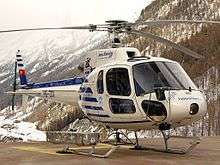
The AS350 has proven popular in a range of roles; multiple cabin configurations can be used, between four and six passengers in a typical seating configuration, and large sliding doors can be fitted to either side of the cabin. In some operators' fleets, the furnishings of the cabin has been designed to enable the internal space and/or equipment fit-out to be rapidly reconfigured to enable aircraft to be switched between roles.[7] Public service operators, such as those in law enforcement, often have forward looking infrared (FLIR) cameras and other mission systems installed on their aircraft. Other optional equipment on offer to operates had included real-time data links, rescue hoists, underslung cargo hooks, electrical external mirrors, search lights, tactical consoles, night vision goggle-compatibility, moving-map system, internal cabin tie-downs, second battery kit, sand filters, wire strike protection system, 4-channel radio, tail rotor arch, cabin floor windows, and removable seats.[7][14]
Modern aircraft have refinements beyond those featuring on older models; these changes include dual-channel FADEC-equipped engines, increasing use of digital avionics in the cockpit, decreased maintenance costs, a re-designed cabin, and a comfortable Stylence interior (optional).[7][14] Older aircraft often undergo refurbishment programs to install aftermarket features, or for the addition of functionality common to newer production aircraft, such as retrofitting of the glass cockpit.[15]
Operational history
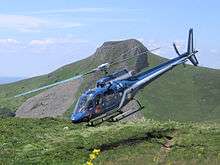
On 14 May 2005, an AS350 B3 piloted by Eurocopter test pilot Didier Delsalle touched down on the top of Mount Everest, at 8,848 m (29,030 ft),[16][17][18] a record that has been confirmed by the Fédération Aéronautique Internationale.[19] On 29 April 2010, a stripped-down AS350 B3 rescued three Spanish alpinists, one at a time, from the slopes of Annapurna I, Nepal at an altitude of 6,900 m (22,640 ft); this set a new record for the highest such rescue.[20] The record was increased to 7,800 m (25,590 ft), during the rescue of Sudarshan Gautam between Camps III & IV in Everest's Yellow Band on the morning of 20 May 2013.[21][22][23][24] On 2 June 2014, an AS350 B3e broke a national record in Mexico by successfully landing on the peak of Pico de Orizaba, at 5,636 metres, the nation's tallest mountain.[25]
The AS350 AStar has been successful in the US market, having become the most popular helicopter platform in use with American governmental agencies, law enforcement being a typical use of the type, by 2015.[26] By 1999, the AS350 had become the prime helicopter being used by the United States Customs Service for light enforcement operations;[27] by 2007, the agency had become the single largest operator of the type in the world.[28] By 2012, out of the 3,300 AS350s in operation across the world, 783 of them were in service with American-based operators.[29]
In the Russian market since 2006, the AS350 and other helicopters built by the manufacturer have been sold and supported by wholly owned subsidiary Eurocopter Vostok; UTair Aviation soon emerged as the largest Russian operator of the AS350 B3e with a fleet of at least 20 of the type.[30]
In December 2014, EASA validation was issued for Airbus Helicopters China to conduct training and support activity at their facility in Shenzhen, China; various components of the AS350 (such as the main and tail gearboxes) are now maintained locally.[31] On 9 September 2015, China's first helicopter leasing company, CM International Financial Leasing Corp Ltd (CMIFL), placed an order for 100 Ecureuil-series helicopters, these are to be a mix of H125 and H130 helicopters.[32][33]
Brazil has been an extensive operator of the AS350; by 2011 more than 300 helicopters were operating in the country, including from the flight deck of the Brazilian aircraft carrier São Paulo.[15][34] Since 1984, the Brazilian Navy has used AS350s to support the Brazilian Antarctic Program.[35] Helibras, a wholly owned subsidiary of Eurocopter, operates in the country; of the 600 helicopters it had domestically manufactured for the Brazilian market by 2012, 70% were AS350s.[36] In January 2011, Helibras signed a contract with the Brazilian Army to substantially upgrade and refurbish their existing fleet of 36 AS350 Ecureuils.[37]
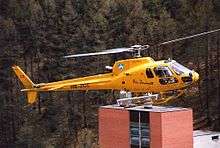
In the United Kingdom, the Defence Helicopter Flying School has operated 26 AS350, designated Squirrel HT1, for the training of pilots of Britain's armed forces; the type was introduced from 1997 onwards as a replacement for the Aérospatiale Gazelle.[38] In September 2014, the UK's Ministry of Defence issued a request for proposals to replace the Squirrel HT1; Airbus Helicopters has already announced its intention to offer a mixed fleet of Eurocopter EC130s and Eurocopter EC135s in response.[39] Since May 1984, the Royal Australian Navy's Fleet Air Arm has operated a fleet of AS350s, these were upgraded to the AS350 BA standard in 1995; the Royal Australian Air Force had previously operated the AS350 for training purposes, and briefly for search and rescue missions, but these were later transferred to the Australian Army.[40]
Between June 2007 and December 2007, the Danish Air Force operated a deployment of four AS350 helicopters at Basra International Airport, Iraq, to perform liaison and reconnaissance missions in support of coalition forces during the Iraq War.[41] In June 2015, the Argentine Defense Ministry ordered 12 H125s to replace their 1970s era Aérospatiale SA 315B Lamas for para-public support missions, such as search and rescue operations, inside Argentina.[42]
Variants
- AS350
- Prototype.
- AS350 Firefighter
- Fire fighting version.
- AS350B
- Powered by one Turbomeca Arriel 1B engine.
- AS350 B1
- Improved version of the original AS350B, which is powered by one Arriel 1D engine, type also fitted with AS355 main rotor blades, AS355 tail rotor with tabs and a tail rotor servo.
- AS350 B2
- Higher gross weight version powered by one Arriel 1D1 engine over the B1 version with aerodynamic strake fitted to tail boom along the starboard side and angled engine exhaust duct for better yaw control.
- AS350 B3
- High-performance version, is powered by an Arriel 2B engine equipped with a single channel (DECU) Digital Engine Control Unit with a mechanical backup system. This helicopter is the first ever to land on the summit of Mount Everest. AS350 B3/2B1 variant introduces enhanced engine with dual channel (FADEC) Full Authority Digital Engine Control, dual hydraulics and a 2,370 kg (5,225 lb) Maximum Take Off Weight. AS350 B3e (introduced late 2011) equipped with the Arriel 2D engine; AS350 B3e renamed H125.[43]
- AS350 BA
- Powered by an Arriel 1B engine and fitted with wider chord AS355 main rotor blades and tail rotor servo.
- AS350 BB
- AS350 B2 variant selected to meet rotary-wing training needs of UK MoD, through its Defence Helicopter Flying School in 1996. Powered by a derated Arriel 1D1 engine to improve the helicopters' life cycle.
- Eurocopter Squirrel HT.1
- Designation of AS350BB operated by the British Military, through the Defence Helicopter Flying School as a training helicopter.
- Eurocopter Squirrel HT.2
- Designation of AS350BB operated by the British Army Air Corps as a training helicopter, based at Middle Wallop. Now retired.
- AS350 C
- Initial variant of Lycoming LTS-101-600A2 powered version developed for the North American market as the AStar. Quickly superseded by AS350D.
- AS350 D
- Powered by one Lycoming LTS-101 engine for the North American market as the AStar. At one stage marketed as AStar 'Mark III.'
- AS350 L1
- Military derivative of AS350 B1, powered by a 510kW (684shp) Turbomeca Arriel 1D turboshaft engine. Superseded by AS350 L2.
- AS350 L2
- Military derivative of AS350 B2, powered by a 546 kW (732shp) Turbomeca Arriel 1D1 turboshaft engine. Designation superseded by AS550 C2.
- HB350 B Esquilo
- Unarmed military version for the Brazilian Air Force. Brazilian designations CH-50 and TH-50. Built under licence by Helibras in Brazil.
- HB350 B1 Esquilo
- Unarmed military version for the Brazilian Navy. Brazilian designation UH-12. Built under licence by Helibras in Brazil.
- HB350 L1
- Armed military version for the Brazilian Army. Brazilian designation HA-1. Built under licence by Helibras in Brazil.
Aftermarket conversions
- Soloy SD1, Super D
- AS350 BA, D powered by an LTS101-600A-3A engine.
- Soloy AllStar
- AS350 BA powered by a Rolls Royce 250-C30 engine.
- Soloy SD2
- AS350 B2 powered by an LTS101-700D-2 engine.
- Heli-Lynx 350FX1
- AS350 BA powered by an LTS101-600A-3A engine.
- Heli-Lynx 350FX2
- AS350 BA or AS350 B2 powered by an LTS101-700D-2 engine.
- Otech AS350BA+
- AS350 BA powered by an LTS101-600A-3A engine.[44]
Operators
The AS350 is in service around the world operated by private individuals, airline and charter operators, emergency medical teams, governments and law enforcement agencies.
Military and government operators
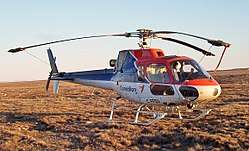
- Argentine National Gendarmerie[45]
- Buenos Aires Province Police[46]
- Austrian Federal Police[47]
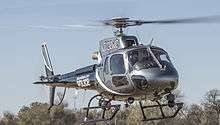
- Central African Republic Air Force[48]
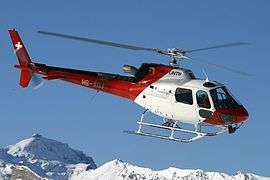
- Guinea Air Force[48]
- Lesotho Defence Force – 3 in service as of January 2019.[62][63]
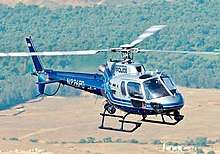
- The Madagascar People’s Armed Forces received three second-hand AS350B2s in June 2019.[64]
- Malawi Army Air Wing[48]
- Pakistan Army Aviation
- Qatar Ministry of Defence — 1 in service, 15 more on order as of January 2019.[67]
- Empire Test Pilots School
- Anaheim Police Department[69]
- Baltimore County Police Department[70]
- California Highway Patrol[71]
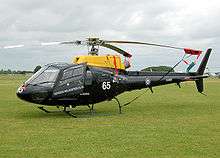
- Los Angeles County Sheriff's Department[72]
- Los Angeles Police Department[73]
- Jefferson County Sheriff's Department, Birmingham, AL
- Miami Police Department[74]
- Miami-Dade Police Department
- Oklahoma City Police Department[75]
- Philadelphia Police Department[76][77]
- San Diego Police Department[78]
- San Jose Police Department[79]
- Suffolk County Police Deprtment[80]
- U.S. Customs and Border Protection[81][82]
- Ministry of Internal Affairs[83]
Notable accidents and incidents
- On 27 July 2007, two AS-350 AStar helicopters from television stations KNXV-TV and KTVK collided in mid-air over Phoenix, Arizona, while covering a police pursuit.[85][86]
- On 15 September 2007, former World Rally Championship driver Colin McRae and three passengers were killed when his AS350 B2 Squirrel,[87] which he was piloting, crashed near Lanark, Scotland.[88][89]
- On 8 August 2009, a Piper PA-32R collided with an AS350 over the Hudson River, with both aircraft crashing into the Hudson River. There were no survivors.
- On 10 June 2012, an AS350 B3e[90] belonging to the Kenya Police Air Wing crashed in Kibiku area in Ngong Forest, west of Nairobi, Kenya, killing at least six people, including Kenya's Interior Security Minister George Saitoti and his deputy Orwa Ojode.[91][92]
- On 7 June 2014, a Helibrás HB-350BA crashed after takeoff, in Aruanã, Goiás state, Brazil. All on board died, including retired soccer player Fernandão.[93]
- On 9 March 2015, two AS350 B3 collided mid air in La Rioja Province, Argentina, killing all 10 people on board both aircraft. The passengers, including a number of French athletes, were participants in the filming of French reality television program Dropped.
- On 11 March 2018, a chartered AS350 carrying six people (five passengers and a pilot) crashed into New York City's East River after reportedly suffering engine failure. All five passengers were confirmed dead after the aircraft submerged upside down into the water. The pilot was able to free himself and was rescued by a nearby tugboat.[94]
- On 27 February 2019, an Air Dynasty AS350 B3e helicopter crashed shortly after takeoff in Taplejung, Nepal, killing all seven people on board, including Tourism and Civil Aviation Minister Rabindra Adhikari.[95]
Specifications (AS350 B3)
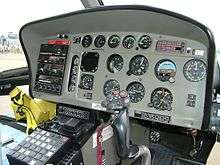
| External video | |
|---|---|
Data from Brassey's World Aircraft & Systems Directory 1999/2000[96]
General characteristics
- Crew: 1
- Capacity: 5 pax
- Length: 10.93 m (35 ft 10 in) (fuselage)
- Height: 3.145 m (10 ft 4 in)
- Empty weight: 1,174 kg (2,588 lb)
- Max takeoff weight: 2,250 kg (4,960 lb)
- Powerplant: 1 × Turbomeca Arriel 2B turboshaft engine, 632 kW (848 hp)
- Main rotor diameter: 10.7 m (35 ft 1 in)
- Main rotor area: 89.75 m2 (966.1 sq ft)
Performance
- Cruise speed: 245 km/h (152 mph, 132 kn)
- Never exceed speed: 287 km/h (178 mph, 155 kn)
- Range: 662 km (411 mi, 357 nmi)
- Endurance: 4 hours 6 minutes
- Service ceiling: 4,600 m (15,100 ft)
- Rate of climb: 8.5 m/s (1,670 ft/min)
Avionics
Vehicle and Engine Monitoring Display (VEMD) with First Limit Indicator (FLI) fitted as standard.
See also
Related development
Aircraft of comparable role, configuration and era
- AgustaWestland AW119 Koala
- Bell 206
- Bell 407
- Enstrom 480
- Kazan Ansat
- Marenco Swisshelicopter SKYe SH09
- MBB Bo 105
- MD Helicopters MD 500
- PZL SW-4
Related lists
References
Citations
- "Eurocopter AS350, AS355 & EC130 Technical Briefing. Archived 12 January 2016 at the Wayback Machine", Airbus Helicopters, February 2010.
- Conklin & de Decker. "Airbus Helicopters AS350B2". Business Jet Traveller. Archived from the original on 28 February 2018. Retrieved 28 February 2018.
- Fabre, François et al., "Final Report: Eurocopter AS350 Ecureuil/Single Engine Family, Revision 4. Archived 27 February 2015 at the Wayback Machine", European Aviation Safety Agency, 8 June 2012.
- "1974: AS350/355 Ecureuil/AStar- AS550/555 Fennec – EC130." Archived 26 December 2015 at the Wayback Machine Eurocopter, Retrieved: 25 December 2015.
- Jackson 2003, p. 244.
- Taylor 1982, p. 56.
- Lombardi, Frank. "AStar Evolution. Archived 26 December 2015 at the Wayback Machine", Aviation Today, 12 May 2015.
- Osborne, Tony. "French Unions Dislike Eurocopter’s U.S. AS350 Plan. Archived 26 December 2015 at the Wayback Machine", Aviation Week, 30 September 2013.
- "Eurocopter to assemble AS350 aircraft in Mississippi. Archived 28 March 2015 at the Wayback Machine", United Press International, 23 September 2013.
- "First US-made Airbus Helicopters AS350 certified. Archived 6 July 2015 at the Wayback Machine", Aerospace Manufacturing and Design, 3 March 2015.
- Forrest, Ben. "Airbus aims to ramp up H125 production in Mississippi." Archived 26 December 2015 at the Wayback Machine Vertical Magazine, 22 December 2015.
- Stephens, Ernie, and James T. McKenna. "The AS350 — Versatility and Power. Archived 16 December 2015 at the Wayback Machine", Rotor & Wing, 1 June 2007.
- "AS350: Hydraulics Out? Fly the Procedure. Archived 26 December 2015 at the Wayback Machine", Rotor & Wing, 1 June 2007.
- "Civil: H125." Archived 11 September 2015 at the Wayback Machine Airbus Helicopters, 2015.
- "Eurocopter’s Helibras Subsidiary to Modernize 36 AS350 Ecureuil Helicopters Operated by the Brazilian Army Aviation Command. Archived 17 June 2015 at the Wayback Machine", Helicopter Maintenance Magazine, 1 February 2011.
- "French Everest Mystery Chopper's Utopia summit". MountEverest.net. 27 June 2005. Archived from the original on 13 January 2015. Retrieved 20 March 2012.
- The Helicopter land on Everest with video
- "Landing on Air". National Geographic Adventure. 1 September 2005. Archived from the original on 2 August 2009.
- "FAI Record ID #11596 – Highest take-off Archived 5 March 2014 at the Wayback Machine" Fédération Aéronautique Internationale (FAI). Retrieved: 20 September 2014.
- "Helicopter Rescues in Everest's Western CWM?". Archived from the original on 23 July 2012. Retrieved 28 February 2012.
- Bierling, Billi (October 2013). "The height of folly?". Action Asia Magazine. Archived from the original on 20 June 2015.
When he fell at the Yellow Band during his descent, Gautam then set another landmark: for the highest helicopter rescue in the world. The Italian pilot Maurizio Folini took on the daring task and used a 'long line' from 7,800 metres to pull the 30-year-old off the mountain. The rescue may also cost Gautam his place in the Himalayan Database as, according to Hawley’s criteria, his climb is not complete.
- Arnette, Alan (28 February 2014). "Everest 2014: Can I be Rescued on Everest?". Archived from the original on 20 June 2015. Retrieved 28 April 2015.
- Sottocornola, Sara (23 May 2013). "Everest, record superato: incredibile recupero vicino a campo 4 per Maurizio Folini". montagna.tv (in Portuguese). Archived from the original on 20 June 2015. Retrieved 28 April 2015.
- Wright, Brian (10 June 2013). "Daring High Altitude Rescue on Everest Sets Record". Rock and Ice, The Climber's Magazine. Archived from the original on 17 April 2015.
- "AS350 B3e breaks record on Mexico's highest mountain. Archived 28 October 2015 at the Wayback Machine", Vertical Magazine, 2 June 2014.
- "Several California Law Enforcement Agencies to Use New AStar Model. Archived 6 June 2015 at the Wayback Machine", Rotor & Wing, 3 March 2015.
- "Congressional Record, V. 145, Pt. 11, July 1, 1999 to July 15, 1999. Archived 1 August 2017 at the Wayback Machine", Government Printing Office, pp. 15192-15193. Retrieved 5 June 2015.
- Schmidt-Creton, Vanessa. "Largest Astar Operator in the US. Archived 12 January 2016 at the Wayback Machine", Airbus Helicopters, 12 July 2007.
- "American Eurocopter Celebrates 200th American-Made AS350 Helicopter. Archived 12 January 2016 at the Wayback Machine", AviationPros, 20 September 2012.
- "Eurocopter Vostok Delivers First Enhanced AS350 B3e Helicopters for Utair Aviation, Which Will Become the Largest Ecureuil Operator in Russia and CIS." Eurocopter, 12 January 2012.
- "Airbus Helicopters Receives EASA Approval for Joint-Venture Training and Support in China." Archived 4 October 2015 at the Wayback Machine, Aviation Today, 15 December 2014.
- Wen, Wang. "Heli-Expo launches with huge order for Airbus." Archived 12 January 2016 at the Wayback Machine, China Daily, 9 September 2015.
- "China Heli-Expo 2015" (3): "Chinese CMIFL sign agreement for 100 H-125/H-130 helicopters over five years." Archived 5 October 2015 at the Wayback Machine, AvioNews, 9 September 2015.
- "Zentech to support Brazilian aircraft carrier São Paulo’s upgrade programme. Archived 14 June 2015 at the Wayback Machine", naval-technology, 7 May 2015.
- Morant, Belen. "The Brazilian Navy: The Ecureuil in Antarctica. Archived 14 June 2015 at the Wayback Machine", Rotor Online, April 2009.
- "Eurocopter Unit Inaugurates Chopper Plant in Brazil.", defensenews, 2 October 2012.
- "Elixir of Youth for AS350 Archived 21 April 2017 at the Wayback Machine", SavunmaSanayi.Net, 6 January 2011.
- "Squirrel HT1. Archived 13 June 2015 at the Wayback Machine", Royal Air Force. Retrieved 6 June 2015.
- Perry, Dominic. "UK MoD begins training helicopter acquisition. Archived 14 July 2015 at the Wayback Machine", Flight International, 10 September 2014.
- "Navy’s ‘Battle Budgie’ turns 30. Archived 19 June 2015 at the Wayback Machine", australianaviation.com.au, 30 May 2014.
- Ripley 2010, p. 297.
- Guevara, Inigo. "Argentina signs MoU for 12 Airbus Helicopters H125s. Archived 2 July 2015 at the Wayback Machine", IHS Jane's Defence Weekly, 29 June 2015.
- "H125". Airbus S.A.S. Archived from the original on 23 February 2018. Retrieved 24 February 2018.
- Reyno, Mike, "Power Play", Vertical December 2006
- "Ecureuil scores success in South America". eurocopter.com. Archived from the original on 24 December 2012. Retrieved 17 February 2013.
- "Control and Prevention". Archived from the original on 21 February 2014. Retrieved 18 December 2012.
- "Austrian Federal Ministry of Internal Affairs". bmi.gv.at. Archived from the original on 5 September 2018. Retrieved 5 September 2018.
- "World Air Forces". Flightglobal Insight. 2015. Archived from the original on 19 January 2016. Retrieved 28 March 2016.
- Lucchesi Air International June 2000, p. 377.
- "PMMG Aeronaves". Archived from the original on 17 August 2018. Retrieved 29 March 2016.
- "R.C.M.P Helicopter". Archived from the original on 18 November 2010. Retrieved 26 January 2005.
- "New Edmonton police helicopter can fly faster, longer than its predecessor". Archived from the original on 24 February 2018. Retrieved 23 February 2018.
- Sanchez, Alejandro (30 November 2017). "Ecuadorian Army acquires two AS 350B3 helicopters". IHS Jane's 360. Archived from the original on 2 December 2017. Retrieved 2 December 2017.
- "French National Gendarmerie AS350 ecureuil". Archived from the original on 15 May 2013. Retrieved 17 February 2013.
- "Archived copy". Archived from the original on 26 December 2017. Retrieved 25 December 2017.CS1 maint: archived copy as title (link)
- "Archived copy". Archived from the original on 26 December 2017. Retrieved 25 December 2017.CS1 maint: archived copy as title (link)
- "Archived copy". Archived from the original on 26 December 2017. Retrieved 25 December 2017.CS1 maint: archived copy as title (link)
- "Hungarian Air Force AS350 ecureuil". Archived from the original on 29 May 2016. Retrieved 27 May 2015.
- "Iceland CG Aircraft". aeroflight.co.uk. Archived from the original on 23 October 2011. Retrieved 17 February 2013.
- "Fast and furious: The new police helicopters". israelnationalnews.com. Archived from the original on 21 August 2017. Retrieved 21 August 2017.
- "Kenya receives Fennec helicopters". IHS Jane's. 6 September 2018. Archived from the original on 7 September 2018. Retrieved 6 September 2018.
- Martin, Guy (January 2018). "Lesotho Defence Force H125". Air International. Vol. 94 no. 1. p. 23.
- "Lesotho Defence Force receives H125 helicopter". Defence Web. 3 January 2019. Archived from the original on 3 January 2019. Retrieved 3 January 2019.
- Martin, Guy (September 2019). "Madagascar's military receives more aircraft". Air International. Vol. 97 no. 3. p. 9. ISSN 0306-5634.
- "Namibian Police Order EC145". Air International. Vol. 81 no. 4. October 2011. p. 34. ISSN 0306-5634.
- "Philippine National Police look to purchase 15 helicopters". HeliHub. 12 October 2012. Archived from the original on 2 April 2016.
- Jennings, Gareth (24 January 2019). "Qatar receives first H125 training helos". Jane's 360. London. Archived from the original on 24 January 2019. Retrieved 24 January 2019.
- Eurocopter Southern Africa Archived 6 April 2013 at the Wayback Machine
- "Anaheim PD buying third helicopter". Orange County Register. Archived from the original on 12 April 2017. Retrieved 4 April 2017.
- "Archived copy". Archived from the original on 1 September 2014. Retrieved 22 August 2014.CS1 maint: archived copy as title (link)
- "Airbus delivers six H125s to four California law enforcement agencies". helihub.com. Archived from the original on 2 April 2016. Retrieved 29 March 2016.
- "LASD Aero Bureau". code2high.com. Archived from the original on 13 September 2014. Retrieved 3 September 2014.
- "Why Is That LAPD Helicopter Circling Overhead?". Archived from the original on 1 March 2014. Retrieved 22 February 2014.
- "N503PH – Aircraft Registration". FlightAware. Archived from the original on 6 April 2017. Retrieved 5 April 2017.
- "Oklahoma City Police Department unveils new helicopters". The Oklahoman. 20 November 2014. Archived from the original on 4 March 2016.
- https://philadelphia.cbslocal.com/tag/philadelphia-police-aviation-unit/. Missing or empty
|title=(help) - https://www.aerospacemanufacturinganddesign.com/article/airbus-helicopters-as350-astar-philadelphia-police-062814/. Missing or empty
|title=(help) - "San Diego Police Air Support Unit". Police Helicopter Pilot. Retrieved 12 September 2019.
- "Get to the chopper: San Jose police get a brand-new eye in the sky". San Jose Mercury News. Archived from the original on 28 July 2018. Retrieved 30 July 2018.
- "PBA On Patrol – Aviation Unit". Retrieved 27 November 2019.
- "Southwest Border Region/ CPB". cbp.gov. Archived from the original on 24 March 2014. Retrieved 17 February 2013.
- "CPB AS 350". Demand media. Archived from the original on 26 April 2014. Retrieved 17 February 2013.
- "Ukraine to buy new rotorcraft from Airbus Helicopters". Jane's 360. Archived from the original on 30 May 2018. Retrieved 26 May 2018.
- Dominguez, Gabriel (1 December 2017). "RAN retires S-70B-2, AS350BA helicopters". IHS Jane's 360. Archived from the original on 4 December 2017. Retrieved 4 December 2017.
- "4 Dead As 2 Helicopters Tracking Police Pursuit Collide". KPHO-TV. 27 July 2007. Archived from the original on 2007-09-27. Retrieved 27 July 2007.
- Midair Collision of Electronic News Gathering Helicopters KTVK-TV, Eurocopter AS350B2, N613TV, and U.S. Helicopters, Inc., Eurocopter AS350B2, N215TV Phoenix, Arizona, July 27, 2007 Archived 19 May 2009 at WebCite (PDF) (Report). National Transportation Safety Board. 28 January 2009. Archived (PDF) from the original on 19 May 2009. Retrieved 28 July 2017.
- "Civil Aviation Authority". Archived from the original on 29 September 2007. Retrieved 16 September 2007.
- "Colin McRae feared dead in helicopter crash – police". Yahoo! News/AFP. Retrieved 16 September 2007.
- Rose, Gareth; Watson, Jeremy (16 September 2007). "Rally ace Colin McRae dies in helicopter crash". The Scotsman. Edinburgh. Archived from the original on 15 November 2007. Retrieved 16 September 2007.
- Mukinda, Fred and Silas Apollo. "Chopper was 'new and powerful'". Daily Nation. 10 June 2012. Retrieved 13 June 2012.
- "Kenyan minister George Saitoti killed in helicopter crash" Archived 31 October 2018 at the Wayback Machine. BBC News. 10 June 2012. Retrieved 10 June 2012.
- "Minister killed in Kenyan helicopter crash" Archived 12 June 2012 at the Wayback Machine. aljazerra.com. 10 June 2012. Retrieved 10 June 2012.
- "Former Brazil and Internacional striker Fernandão dies in helicopter crash". 7 June 2014. Archived from the original on 7 June 2014. Retrieved 7 June 2014.
- Justin Carissimo (11 March 2018). "5 killed in New York City helicopter crash on river". CBS News. Archived from the original on 12 March 2018. Retrieved 12 March 2018.
- "Seven people, including tourism minister, killed in a helicopter crash". Kathmandu Post. Archived from the original on 28 February 2019. Retrieved 28 February 2019.
- Taylor 1999, p. 377.
- "Archived copy". Archived from the original on 29 February 2012. Retrieved 25 February 2012.CS1 maint: archived copy as title (link)
- "Archived copy". Archived from the original on 26 February 2012. Retrieved 25 February 2012.CS1 maint: archived copy as title (link)
Bibliography
- Hoyle, Craig. "World Air Forces Directory". Flight International. Vol 180 No 5321, 13–19 December 2011. pp. 26–52.
- Jackson, Paul. Jane's All The World's Aircraft 2003–2004. Coulsdon, Surry, UK: Jane's Information Group, 2003. ISBN 0-7106-2537-5.
- Lucchesi, Claudio. "Brazilian Police Air Unit: São Paulo's Police Eagles". Air International, June 2000, Vol. 58, No. 6. pp. 376–378.
- Ripley, Tim. Middle East Air Power in the 21st Century. Casemate Publishers, 2010. ISBN 1-8488-4099-3.
- Taylor, John W. R. Jane's All The World's Aircraft 1982–83. London: Jane's Yearbooks, 1982. ISBN 0-7106-0748-2.
- Taylor, Michael J. H. Brassey's World Aircraft & Systems Directory 1999/2000. London: Brassey's, 1999. ISBN 1-85753-245-7.
External links
| Wikimedia Commons has media related to Airbus Helicopters H125 Écureuil. |
